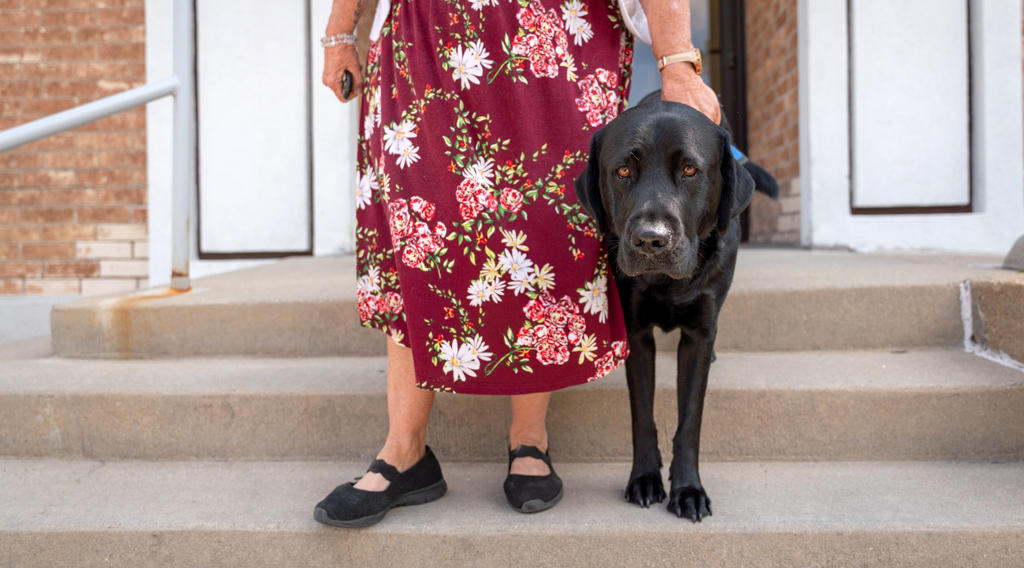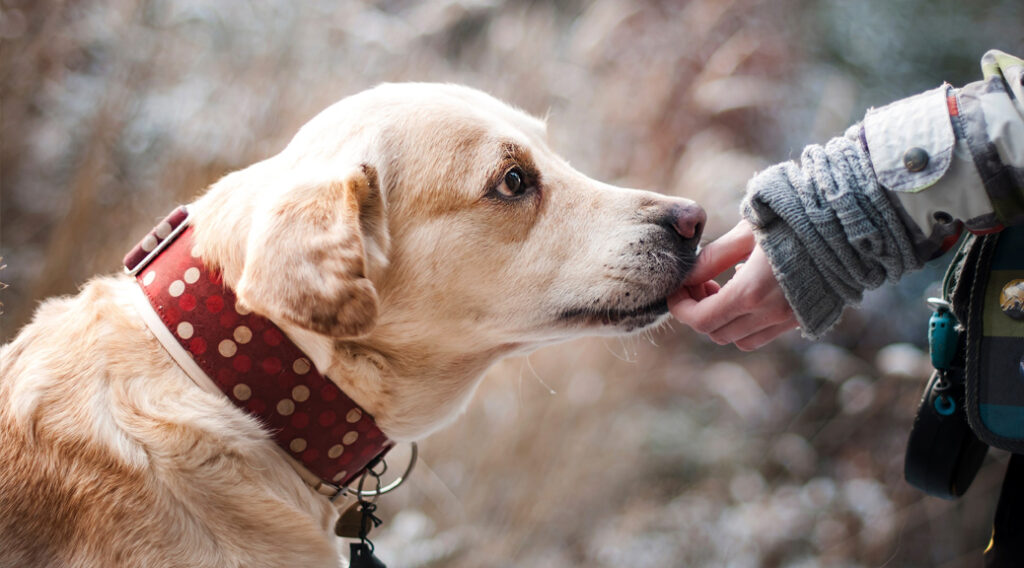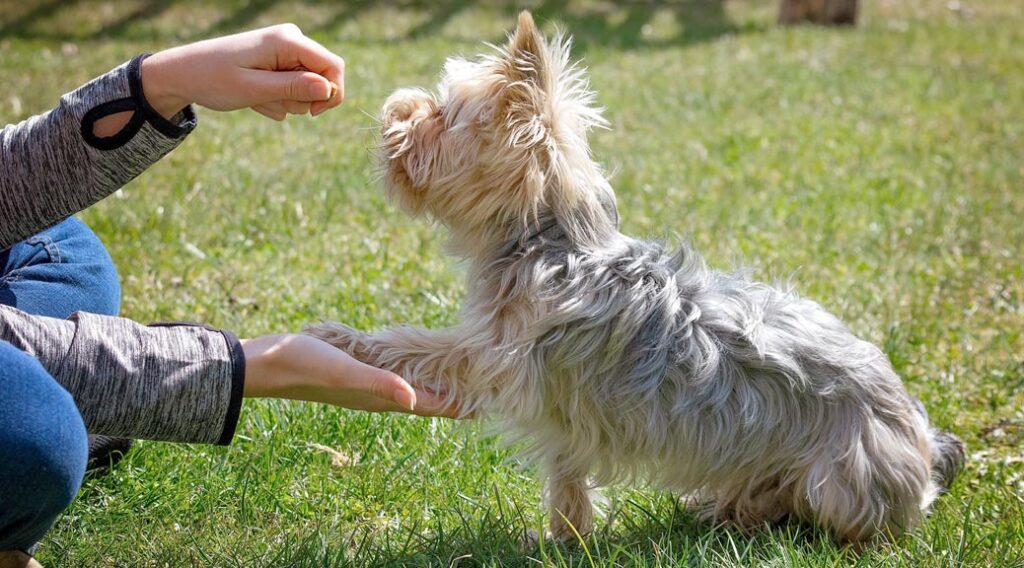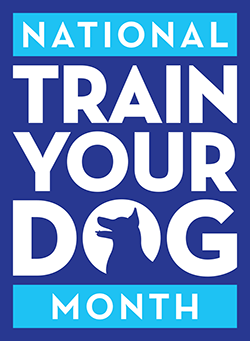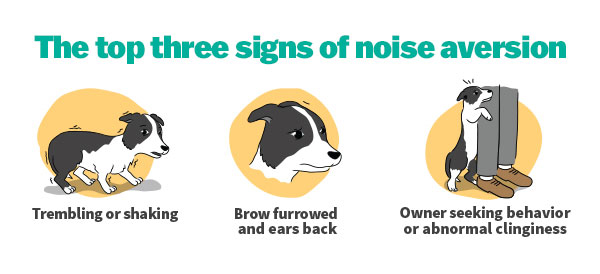Celebrating International Assistance Dog Week
Starting the first Sunday of every August, we are called on to observe International Assistance Dog Week, an awareness campaign launched by Assistance Dogs International (ADI) to celebrate assistance dog trainers, program staff, volunteers and the dogs’ human partners.
In announcing the initiative in 2022, ADI Executive Director Chris Diefenthaler explained, “Everyone loves an assistance dog, and quite rightly the dogs tend to take center stage.
“International Assistance Dog Week is a chance for us to recognize and celebrate the people at the other end of the leash—those who devote their time and expertise to ensuring ADI-certified assistance dogs are trained and work to the highest standards.”
Now the world’s leading standards-setter and accreditation body for training assistance dogs, ADI was founded in 1986 as a coalition of seven non-profit programs training and placing assistance dogs.
Based on the most recent information available, ADI’s 168 accredited member organizations were supervising a total of 28,372 active assistance dog-handler teams, including 13,351 service dogs (47%), 12,753 guide dogs (45%) and 2,268 hearing dogs (8%).
Within the general service dog category, ADI’s worldwide 2023 census showed the types of services allocated this way:
- Mobility service dogs 48%
- PTSD Veterans Service Dogs 23%
- Autism Service Dogs 18%
- Psychiatric Service Dogs 4%
- Seizure alert service dogs 3%
- Diabetic alert service dogs 3%
- Medical Alert Service Dogs 1%
ADI counted an additional 3,770 placements, including 2,172 facility dogs, 650 companion/therapy dogs and 948 “other types.”
Carrying out the work of ADI-member organizations as of the end of 2023 were 5,077 full-time and 1,911 part-time employees and 52,0215 volunteers. There were 10,969 dogs and puppies in training with ADI-accredited member programs and 8,481 potential clients on waiting lists.
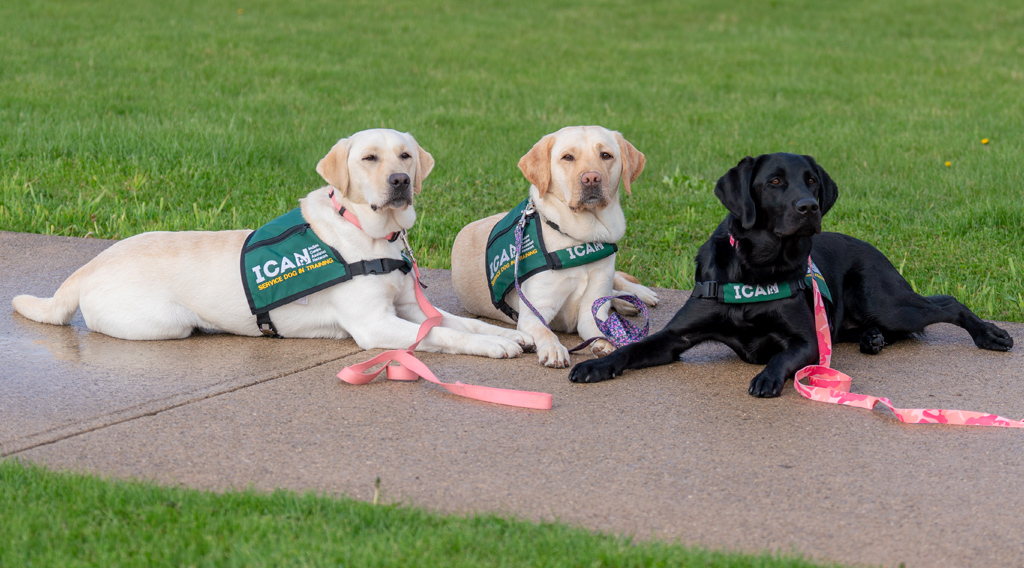
Indiana Canine Assistance Network—ICAN
Established in 2002, Indiana Canine Assistance Network (ICAN) is our state’s only ADI-accredited assistance dog training program and is one of 44 ADI-accredited organizations worldwide operating prison-based training programs.
With locations in Zionsville and Fort Wayne, ICAN currently places four types of assistance dogs—
- Mobility assistance dogs to help human partners who use wheelchairs, walkers or canes or who have balance issues. These dogs can also complete many other helpful tasks on cue.
- Facility assistance dogs to do specific, skilled tasks to support people frequenting places like schools, hospitals, nursing homes and rehabilitation centers.
- Psychiatric assistance dogs, currently helping military veterans manage service-related post-traumatic stress disorder (PTSD), traumatic brain injury and military sexual trauma.
- In-home skilled companion dogs to help with everyday tasks and challenges, such as picking up and retrieving named objects, opening and closing doors and cabinets, helping human partners keep their balance around the house and getting help or pushing a medical alert button to contact emergency personnel.
The total cost to raise and train each dog is $32,000.
After paying a $75 application fee, approved clients pay a $2,900 fee for their dog, with donations covering the remaining costs.
Veterans, who are most often referred to ICAN through the Veteran Affairs Northern Indiana Health Care System, apply for and receive their assistance dogs at no cost.
At the time it published its 2024 annual report, ICAN had more than 110 clients and active service dogs, more than 260 active volunteers, more than 80 incarcerated trainers and 85 service dogs in training.
During 2024, ICAN placed 17 graduate dogs and added 25 puppies to the program.
“We have 50 to 60 people on our waiting list, and we’ve been graduating 10 to 20 dogs a year,” noted ICAN Communications Manager Samantha Thompson.
This short (2:33) video, “About ICAN,” from the ICAN YouTube channel provides an overview of the organization.
What an Assistance Dog Is
“Assistance dog” is an umbrella term referring to a guide, hearing alert or service dog specifically trained to perform, in response to cues, tasks that directly mitigate the human partner’s disability. Assistance dogs may learn to respond to between 60 and 80 cues from their partners, including words, hand signals, gestures, sounds and medical symptoms.
Besides learning to perform specific tasks related to their partner’s mental or physical disability, assistance dogs also undergo hours of training and assessment to manage their behavior in public.
Guide dogs are assistance dogs who provide guidance and direction for people with impaired vision, making it easier to navigate streets and buildings, avoid obstacles, stop at curbs and use public transportation.
Hearing dogs assist by signaling particular sounds—like doorbells, alarm clocks, oven buzzers, telephones, crying babies and smoke alarms—to their hearing-impaired partners by making physical contact and leading them to the source of the sound.
Service dogs work for human partners with a range of disabilities other than blindness and deafness and include—
- Mobility service dogs
- Seizure service dogs
- Autism service dogs
- Psychiatric service dogs
- Service dogs for veterans with post-traumatic stress syndrome
- Medical alert service dogs
Among the many, but far from all the ways service dogs support their partners—
- Providing balance or counterbalance needed to walk
- Bracing against them to help them get up off the floor or move from a wheelchair to a sofa or bed
- Retrieving dropped objects
- Pulling wheelchairs
- Opening and closing doors
- Operating light switches
- Reminding them to take medicine
- Alerting them to a coming seizure or anxiety attack
- Detecting and warning about high or low blood sugar levels
- Barking to summon help
- Finding and leading another person to the partner
More than just a presence in their workplace, facility dogs are trained to perform specific, skilled tasks to support a variety of people in commonly-occurring situations experienced in business, health care and educational settings. Facility dogs live full-time with a primary handler—most often an employee at the facility where the dog works.
Although they are deeply loved as part of their handlers’ families and among people at the facilities where they serve, assistance dogs are not pets.
They are working dogs.
What an Assistance Dog is Not
Therapy dogs are usually pets qualified through a therapy dog organization to provide comfort to people they encounter in settings such as schools, hospitals and nursing homes or disaster areas. They have calm temperaments and, perhaps, training in basic obedience skills, but they are not trained to perform specific tasks to address a human partner’s particular disabilities.
An emotional support animal (ESA) is any animal—often a dog—prescribed by a medical health care professional to relieve their owner’s symptoms of mental illnesses such as anxiety, depression or phobias. While their presence is comforting to their owners, ESAs typically receive no special training to perform specific tasks or to behave well in public.
Therapy dogs and emotional support animals are not considered assistance dogs, and it is illegal in Indiana to pretend to have a disability and represent a pet as an emotional support dog.
Dogs whose owners keep them solely for protection, personal defense or companionship—while all useful canine services—are not assistance dogs.
Assistance Dogs and Public Access
The Americans with Disabilities Act (ADA) grants people with disabilities access to public places—including places normally off-limits to dogs—with their service dogs. The service animal must be under the handler’s control at all times.
To be considered a service animal as defined by the ADA, the dog must have been “individually trained to do work or perform tasks for an individual with a disability. The task(s) performed by the dog must be directly related to the person’s disability.”
There is no need for the dog to wear a vest, leash, harness or collar identifying it as a service dog. When it is not obvious a dog is a service animal, the ADA allows only two questions to be asked:
- Is the dog a service animal required because of a disability?
- What work or task has the dog been trained to perform?
The questioner may not ask for documentation for the dog, ask about the nature of the disability or demand a demonstration of the task by the dog.
The ADA website warns, “There are individuals and organizations that sell service animal certification or registration documents online. These documents do not convey any rights under the ADA and the Department of Justice does not recognize them as proof that the dog is a service animal.”
Therapy dogs and emotional support animals are not considered service dogs under the ADA because they are not typically trained for specific tasks or duties to help a person with a disability.
Owners of prescribed emotional support animals do have rights under the Fair Housing Act to “reasonable accommodations” for the animals, even in buildings that don’t allow pets.
The government’s ADA website offers detailed guidance on the term “service animal” and authoritative answers to frequently-asked questions about service animals and the ADA.
ICAN Assistance Dogs from Birth to Placement
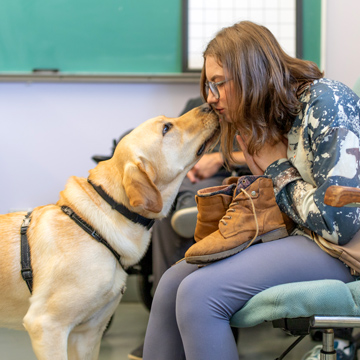
Preparing an ICAN assistance dog for work as a mobility service dog or a facility dog is a collaborative effort shared by multiple qualified volunteers, staff members and inmate handlers that takes about two and a half years from the dog’s birth to placement with a client.
ICAN owns a number of breeder dogs of its own and also diversifies its gene pool by participating in ADI’s ABC Breeding Cooperative, along with other ADI-accredited service dog organizations.
Most ICAN-bred dogs are purebred Labrador Retrievers or Golden Retrievers or cross-breeds of the two.
The breeder dogs live with volunteer breeder caretakers who foster the dogs throughout their reproductive years and have the option to adopt them at the end of their breeding careers.
After observing and assisting with birthing litters and caring for newborn puppies, volunteer litter hosts take pregnant breeder dogs into their homes in the weeks before the litter is due and oversee the puppies’ birth and care during their first eight weeks.
Litter sitters volunteer to spend several hours at a time with new litters as the puppies begin to be weaned and learn how to be away from their littermates, how to eat solid food and how to accept being handled and having their paws and ears touched.
Volunteer puppy raisers care for the puppies between ages eight and 16 weeks, teaching house manners and basic cues while socializing them to the world of unfamiliar surfaces, smells, sounds and situations—experiences crucial to building social skills and confidence.
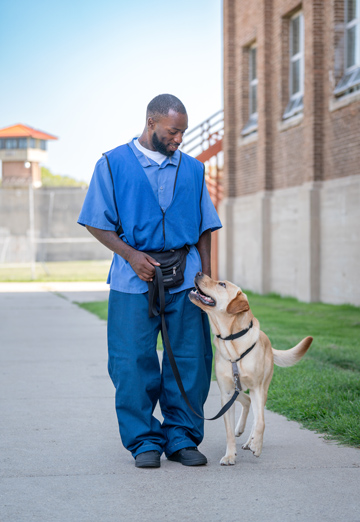
At 16 weeks of age, the puppies go to the correctional facilities to live with their assigned inmate handlers, who are fully committed to caring for and training their dogs.
ICAN’s inmate-handlers are incarcerated at Indiana Women’s Prison—a maximum security prison in Indianapolis, Pendleton Correctional Facility—a maximum security prison for adult males in Pendleton, and Correctional Industrial Facility (CIF)—a medium-security prison in Fall Creek Township near Pendleton.
As with most jobs available to inmates, the Department of Corrections pays ICAN’s inmate handlers for their services, providing modest compensation that can be used for purchases from the prison commissaries.
ICAN’s Indianapolis-based staff training manager visits the three prisons regularly to teach the inmate handlers how to train the dogs to be mobile assistance and facility service dogs.
Every six weeks, the in-training dogs leave the correctional facilities to spend three-week visits with furlough volunteers who take the dogs into their homes and expose them to everyday experiences and real-world situations they are likely to encounter beyond prison walls.
Indiana law permits people handling service dogs in training to enter public facilities accessible under ADA regulations to fully-trained dogs, allowing furlough volunteers to visit stores, restaurants, theaters, hospitals and other locations the dogs will likely encounter once they are on the job.
While they don’t teach the dogs any new cues, furlough volunteers practice cues the handlers have already taught the dogs in these varied locations and circumstances.
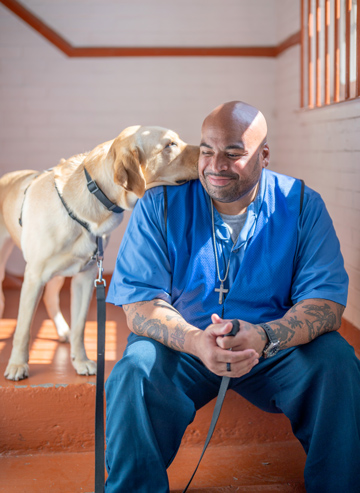
These alternating six-week periods in the correctional facility and three-week periods on furlough continue until the dog is two to two and a half years old and ready for placement.
As each dog matures, ICAN’s client success manager consults with the training manager to determine what work will best suit the dog, and the inmate handler begins to focus on teaching the cues that will prove most relevant and useful once the dog is placed in that role with an ICAN client.
Finally, the client success manager matches the dog with the selected client who spends five days at the prison in team training, learning from the inmate handler how to work with the dog.
“After team training, we have an informal graduation when the handler hands over the leash to the client,” said Thompson. “It’s a very emotional day.”
Once placed, ICAN assistance dogs remain in service an average of eight to ten years.
ICAN’s Fort Wayne-based training manager works with veterans and foster volunteers to train dogs for psychiatric service work. These dogs may be purebreds or mixed-breeds from shelters or rescue organizations, chosen for their aptitude for providing the services needed. If suitable for the work, the veteran’s own dog may be trained as a psychiatric service dog.
Psychiatric service dogs are typically matched and placed with veterans when they’re about a year old based on the dog’s skills, temperament and size relative to the veteran’s needs. Once the dog is living in the veteran’s home, ICAN’s Fort Wayne training manager works with the veteran for six to 12 months to train the dog. After the dog passes assessments, the veteran and the service dog graduate from the ICAN program.
All training is based on “Least Intrusive, Minimally Aversive” or LIMA techniques. See our post “Training the LIMA Way” for more information about this enlightened approach to dog training.
See “What Is ICAN?” for a 4:45 look at assistance dogs at various stages of training and development.
For an overview of the roles volunteers play at ICAN, see 4:07 video “Become an ICAN Volunteer.”
To understand the impact of the ICAN program on inmate handlers, see the 5:58 video “ICAN Handler Program 2023.”
Here are selected videos showing clients and their ICAN assistance dogs:
“Rex and Lunar” 1:04
“Nicholas & Purdue, a Client Testimonial” 1:29
“ICAN Celebrates International Assistance Dog Week!” 3:12
“Emily, Mary and Olivia – ICAN Brings Hope!” 4:41
“Forest the School Dog” 2:39
“Facility Dog, Rainier at Community Hospital Anderson” 2:54
“Meet Suzanne Smith: An ICAN client and Army National Guard veteran” 4:43
Applying for an Assistance Dog
The ICAN website’s “Apply for a Service Dog” tab on the main menu leads to a page listing eligibility requirements and outlining the entire process of securing a mobility assistance dog from application through graduation.
This page also leads to information on applying for a facility dog.
The average wait time from application to being matched with a service dog can be one to three years, depending on the applicant’s needs, the number of clients on the waiting list and the availability of a dog that’s right for the applicant.
The goal for veterans’ wait times is no more than a year.
To see if you qualify before applying for an ICAN dog, visit the Service Dog Eligibility and FAQ page.
The ICAN website directs veterans to a different form as their eligibility and application process is specialized for their particular needs.
“The way our Fort Wayne office operates to serve veterans is a little different from our traditional program,” said Thompson.
“Right now, we are placing psychiatric service dogs with veterans in a 10-county area surrounding Allen County, where our Fort Wayne branch is located,” said Thompson. “Longer term, we expect to expand to serve veterans living anywhere in Indiana.”
According to ADI, “It is a buyer beware market for consumers looking for a reputable assistance dog program.”
“If you need something other than a mobility assistance dog, a facility dog or a psychiatric service dog and ICAN is not a match, we will refer you to the ADI website where you can find the nearest member program that has dogs to fit your needs.”
“If anybody comes to us looking for a different type of dog, we always refer to ADI,” said Thompson. “It’s always best to go with an accredited program. You always know they’re reputable if you go with an ADI-member organization.”
To Get Involved
To become part of ICAN’s mission to provide independence, break barriers and help Indiana children, adults and veterans overcome challenges by breeding, training and placing assistance dogs, consider—
- Participating in one of ICAN’s special events,
- Volunteering and
- Making a donation.
“Our president always says our mission is irresistible,” said Thompson. “However you choose to get involved and to what extent, you can be sure you’ll be making a difference that transforms many lives.”
Celebrating International Assistance Dog Week Read More »

